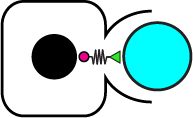Fundamental Mechanisms of Phagocytosis
Phagocytosis is an ancient immunological process that enables organisms to selectively recognize and eliminate non-self and dead and damaged self. Phagocytes are immune cells that carry out this process by using transmembrane protein receptors as molecular hands to recognize and eat specific targets. We are interested in learning how these receptors initiate phagocytosis with the aim of defining fundamental mechanisms underlying immunity across phyla.

Cellular eating machines for therapy
We developed a method to program phagocytes by replacing an engulfment receptor's extracellular domain with a synthetic receptor-ligand module or an antibody that binds an antigen of interest. Synthetic phagocytes expressing engineered receptors efficiently eat targets of therapeutic interest (e.g. cancer cells). We are currently building new synthetic receptors that expand the capabilities of programmed phagocytes.

How do phagocytes use physical cues to decide what to eat?
The chemical “eat-me” and “don’t eat-me” phagocytes use to differentiate between dangerous targets and innocuous healthy self are well understood. In contrast, how phagocytes use physical information to decide what to eat remains an open problem. In collaboration with Prof. Xuemei May Cheng's group at Bryn Mawr, we are currently building new tools to define the mechanobiology of phagocytosis.

